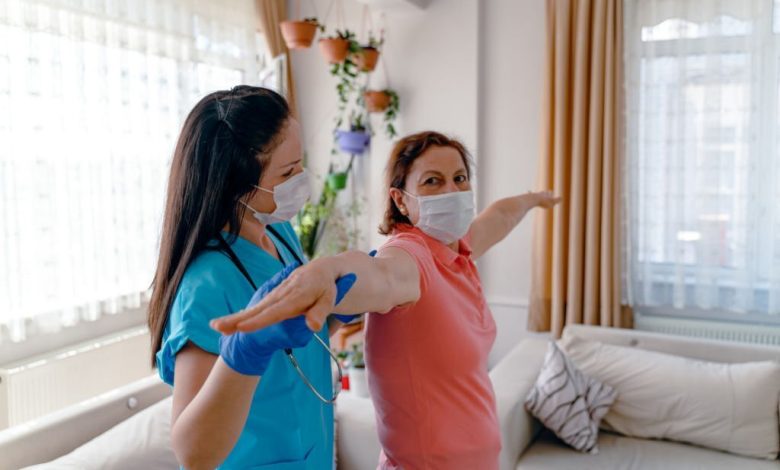Back Pain Conditions Affecting Women

We all have at least one woman in our family who suffers from one of these back pains, whether a herniated disc, sciatica, hormonal low back pain, or back pain associated with pregnancy. Recent research has shown that women are more prone to a range of back pain. Women suffer from chronic back pain, some of which only affects women. After delivering a baby, most women cannot regularly travel to physiotherapy sessions, so here, we are bringing home healthcare services in Mumbai with all the necessities required for you.
The higher incidence of back pain in women can be caused by changes in the pelvic muscles during pregnancy and childbirth, hormonal changes during the reproductive phase and changes after menopause. In addition, most women have caring roles as mothers or maternal authority in the home. Often starts a cycle of overuse injuries to the back muscles.
Here are 8 back pains that primarily affect women:
-
Tailbone
coccydynia or tailbone Pain at the base of the spine is four times more common in women than in men. The pain area often feels tender and can be painful. It can be caused by accidents, falls, pregnancy-related injuries, or poor posture. The pain can severely interfere with daily activities such as sitting, driving, and housework. Getting physiotherapy is the only best option to reduce the pain faster. We assure you the best physiotherapy at home in Mumbai.
-
Back pain in women during and after pregnancy
Pregnancy causes the release of relaxation hormones that cause the pelvic floor muscles to relax, and the fetus grows during pregnancy as the muscles get relaxed. After birth, the relaxation secretion stops, but the loss of proper muscular support of the spine can make the body vulnerable to back pain. Radically changing weight distribution and Centre of gravity can increase pressure around the spine and cause back pain, hormonal low back pain and even sciatica in women.
Hormonal low back pain is one of the most common complications of pregnancy, especially in the final months. The pain usually goes away when the baby is born. In many women, however, the hormonal lower back pain persists months after giving birth. A hormone relaxes the ligaments in the pelvic joints, which get flexible for the delivery of a baby through the birth canal. Hormonal low back pain can occur when joints become too flexible.
-
Compression fracture
Bone demineralization occurs more rapidly in postmenopausal women. which causes a condition known as osteoporosis. Bones lose their functional integrity and become prone to fracture. The most common site in women is a compression fracture in the spine. It can often go unnoticed until the loss of altitude becomes apparent. However, pain from pressure on surrounding structures can lead to severe back pain in women.
-
Osteoarthritis of the Spine
Osteoarthritis of the spine occurs when age-related changes cause the layers of cartilage to wear away. The height of the intervertebral discs is reduced as they dry out. Degenerative changes in the facet joints leading to loss of cushioning, leading to back pain in women, especially after age 45.
-
Piriformis Syndrome
Piriformis syndrome in women is expected due to pregnancy-related changes and fluctuating hormone levels. The piriformis muscle becomes inflamed, causing compression and irritation of the sciatic nerve. This pain radiates down the leg, making routine activities painful.
-
Fibromyalgia
Fibromyalgia causes widespread pain throughout the body. Which usually happens after medical treatment, an operation, an accident, or psychological stress. The pain is also accompanied by tension, fatigue, headaches, TMJ disorders, depression, or anxiety. Symptoms begin gradually and may not have a specific triggering event. Our home healthcare services in Mumbai also offers psychological support.
-
Degenerative spondylolisthesis
women develop degenerative spondylolisthesis after the age of 50. One of the vertebrae slides forward over the other. Which may not be accompanied by a fracture of the pars interarticularis. Spondylolisthesis causes increased pressure on the structures around the affected area. It leads to severe leg and back pain when an outgoing nerve root is compressed.
-
Sacroiliac Joint Dysfunction
The sacroiliac joints in women are quite different from those in men. The small articular surface causes higher pressure on the sacroiliac joints. Changes in the strength and flexibility of the muscles around these joints during pregnancy often lead to dysfunction. The joints become malignant; the soft tissue structures are unevenly stretched. The pain usually occurs in the lower back and can spread to the hips and thighs.
9. Tailbone Pain in Menopause
Many symptoms, including tailbone pain, are related to perimenopause. Research proves that there is a link between tailbone pain and menopause. Menopause severe tailbone pain is also linked to vitamin D deficiency. A drop in estrogen levels decreases vitamin D levels, which can be painful if not treated properly. Tailbone pain during menopause can come gradually or suddenly after impacting the area near the end of the spine.
Although childbirth or backward falling are the most common causes of coccyx discomfort, doctors cannot always pinpoint the cause. The symptoms usually disappear within a few weeks or months but can become chronic and affect daily activities, such as driving or bending over. Because the tailbone is not flexible enough to flex under pressure, injuries to the tailbone, the surrounding ligaments, or both can occur.
Treating Back Pain
Back pain can affect women of any age, starting as early as puberty. The cause of back pain in women varies depending on the changes that a woman’s body undergoes at various stages of life. Pregnancy, childbirth, weight gain, weight loss, and changes in hormone levels can cause multiple back pain symptoms. Proper treatment and physiotherapy sessions can help relieve back pain.so contact us for the best-skilled physiotherapy at home in Mumbai with all the comfort and faster pain recovery.



